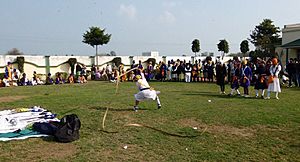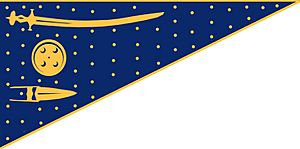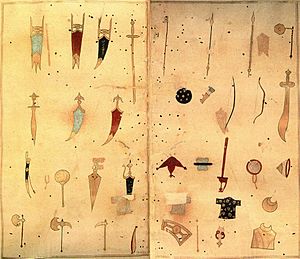Gatka facts for kids
Gatka is a South Asian martial art most commonly practised in the Punjab region. Though today generally identified with Punjabi Sikhs, it has also traditionally been practiced by other ethno-cultural groups in India and Pakistan, in various parts.
The word gatka properly refers to the wooden sticks which were originally used for sparring in this sport although now a range of other weapons are also employed.
Gatka can be practiced either as a contact sport (khel) or ritual/ceremonial demonstration (rasmi).
Contents
History
The Sikhs have a long history of martial traditions, ultimately rooted in pre-modern schools of martial arts or śastravidyā of the Rajputs, and the kshatriya caste or India's "Martial Races" more generally.
Guru Hargobind propagated the theory of the warrior saint, and emphasized the need for his followers to practice fighting for self-defence. Guru Gobind Singh, the 10th guru of Sikhism, trained in martial arts in the Panjab. One of his achievements was the founding of Khalsa, the collective society that galvanized the martial energies of the Sikh community and formed the Khalsa Army of the Sikh Empire during the first half of the 19th century. In regards to training the Khalsa, he pledged that he would "teach the sparrow to fight the hawk".
Following the Second Anglo-Sikh War of 1848 to 1849 and the establishment of the British Raj, the Sikh martial traditions and practitioners suffered greatly. The British ordered effective disarmament of the entire Sikh community; even tools and farming equipment were banned. During the Indian Rebellion of 1857, the Sikhs assisted the British in crushing the mutiny. As a consequence of this assistance, restrictions on fighting practices were relaxed, but the Panjabi martial arts which re-emerged after 1857 had changed significantly.
Instead of producing soldiers for warfare, the Shaster Vidiya had developed during the 1860s into a new fighting style called gatka (from the name of its primary weapon, the sword training stick) which was mainly practiced by the British Indian Army. As Sikh colleges opened in the Panjab during the 1880s, European rules of fencing were applied to Gatka, resulting in further alteration. This led to the formation of two gatka branches, rasmi (ritualistic) and khel (sport).
The system devised by Captain William Ewart Fairbairn and Captain Eric Anthony Sykes borrowed methodologies from gatka, jujutsu, Chinese martial arts and "gutter fighting". This method was used to train soldiers in close-combat techniques at the Commando Basic Training Centre in Achnacarry, Scotland.
Weapons
The correct use of melee weapons is central to gatka with techniques depending on the nature of the weapon. The sword is gatka's main weapon is often paired with a shield. Throwing weapons are also used like the Chakram. Along with daggers and types of spears etc. Weapons used in gatka include:
- Talwar: curved sword
- Kirpan: Sharp dagger worn by baptized sikhs at all times
- Lathi: stick of bamboo from one to three meters in length
- Flexible weapons, such as whips and chains.
- Churi: knife
- Bow and arrow: either traditional Indian steel recurve bows or true composite bows made of wood, horn and sinew. Arrows used are usually fletched reed arrows with tanged steel points.
- Barcha: spear
- Khanda: traditional Sikh and Rajput straight sword
- Peshkarj: dagger
- Kukri: bent sword which broadens towards the point
- Chakram: circular edged weapon that can be thrown. Smaller specimens can be worn like bangles and used as brass knuckles.
- Bagh nakh: leopard's claw, a spiked weapon worn on the hand similar to the Japanese shuko
- Katara (कटार): dagger able to pierce armor
And many more
Training
With its strong link to the Sikh faith, gatka groups may train in a religious or semi-religious situation, such as in a gurdwara (Sikh temple). Akharas, usually associated with pehlwani, have also been founded with the exclusive purpose of teaching gatka. Gatka emphasizes having something in both hands eg two sticks, a stick and a sword, a sword and a shield or any other combination. Training with "both hands full" is believed to be an excellent exercise for coordinating the two halves of the body, a concept also found in many Filipino martial arts. The individual's preference for weapons, combination of weapons, and movement patterns leads to the development of individual fighting methods.
The foundation of the art is a movement methodology for the use of the feet, body, arms and weapons in unison. Gatka favors rhythmic movement, without hesitation, doubt or anxiety. The attacking and defense methods are based upon the positions of the hands, feet and weapon(s) during the dexterity regimen.
Chanting holy verses may accompany these exercises. The three-beat-per-cycle played by a drummer adds to the coordination during practice.
Images for kids
See also
 In Spanish: Gatka para niños
In Spanish: Gatka para niños







